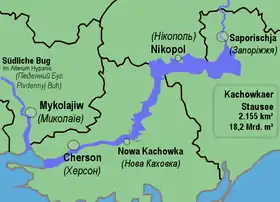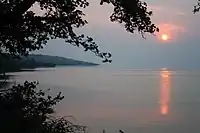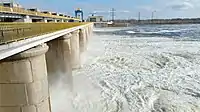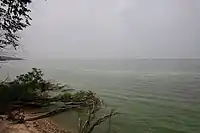Kakhovka Reservoir
The Kakhovka Reservoir (Ukrainian: Каховське водосховище, romanized: Kakhovs′ke vodoskhovyshche) is a water reservoir on the Dnieper River in Ukraine. It was created in 1956, when the Kakhovka Hydroelectric Power Plant was built. It is one of several reservoirs in the Dnieper reservoir cascade.
| Kakhovka Reservoir | |
|---|---|
 Map of the Kakhovka Reservoir | |
 Kakhovka Reservoir | |
| Location | Kherson, Zaporizhzhia and Dnipropetrovsk Oblasts |
| Coordinates | 47°28′N 34°10′E |
| Type | Hydroelectric reservoir |
| Primary inflows | Dnieper River |
| Primary outflows | Dnieper River |
| Basin countries | Ukraine |
| Max. length | 240 km (150 mi) |
| Max. width | 23 km (14 mi) |
| Surface area | 2,155 km2 (832 sq mi) |
| Average depth | 8.4 m (28 ft) |
| Max. depth | 26 m (85 ft) |
| Water volume | 18.2 km3 (14,800,000 acre⋅ft) |
| Surface elevation | 44 m (144 ft) |
Geography
The reservoir covers a total area of 2,155 square kilometres in the Kherson, Zaporizhzhia, and Dnipropetrovsk Oblasts of Ukraine.[1] It is 240 km long and up to 23 km wide. The depth varies from 3 to 26 metres and averages 8.4 meters. The total water volume is 18.2 km3.
It is used mainly to supply hydroelectric stations, the Krasnoznamianka Irrigation System, the Kakhovka Irrigation System, industrial plants such as the 5.7 GW Zaporizhzhia Nuclear Power Plant, freshwater fish farms, the North Crimean Canal and the Dnieper–Kryvyi Rih Canal.[2] Its creation formed a deep-water route for ships to sail up the Dnieper.
2022 Russian invasion of Ukraine
Beginning in early November 2022, Russia opened the spillways at the Kakhovka Hydroelectric Power Plant and the reservoir dropped to its lowest level in 3 decades, putting at risk irrigation and drinking water resources as well as the coolant systems for the Zaporizhzhia Nuclear Power Plant. Between December 1, 2022, and February 6, 2023, the water level dropped 2 meters.[3] The purpose of the discharge is unclear. It could be a way to harm Ukrainian agriculture, but most of the affected agricultural areas are in Russian-held parts of Ukraine.[3] The Zaporizhzhia Regional Military Administration suggested that the motive might have been in part to flood the area south of the dam in order to keep Ukrainian Forces from crossing the Dnipro River.[3] After reaching a low point the water level began to rise after the Ukrainian government began filling it with water from other reservoirs on the Dnipro River. "All of this poses a threat of lowering the water level to a critical level throughout the whole cascade of Dnipro reservoirs in Ukraine," said Ukraine's Ministry of Environmental Protection and Natural Resources.[4] The Russia–Ukraine conflict has had a profound impact on water resources and water infrastructure.[5]
Gallery
References
- "КАХОВСЬКЕ ВОДОСХОВИЩЕ" [KAHOVSKY WATER RESERVOIR]. leksika.com.ua. Retrieved 2020-06-12.
- "Каховське водосховище | Енциклопедія Сучасної України" [Kakhov reservoir | Encyclopedia of Modern Ukraine]. esu.com.ua. Retrieved 2020-06-12.
- "Russia is draining a massive Ukrainian reservoir, endangering a nuclear plant". NPR. 6 February 2023.
- "A shrinking reservoir signals Ukraine and Russia are waging a dangerous water war". NPR. 2023-03-22. Retrieved 2023-04-13.
- Shumilova, Oleksandra; Tockner, Klement; Sukhodolov, Alexander; Khilchevskyi, Valentyn; De Meester, Luc; Stepanenko, Sergiy; Trokhymenko, Ganna; Hernández-Agüero, Juan Antonio; Gleick, Peter (2023-03-02). "Impact of the Russia–Ukraine armed conflict on water resources and water infrastructure". Nature Sustainability. Springer Science and Business Media LLC. doi:10.1038/s41893-023-01068-x. ISSN 2398-9629.



